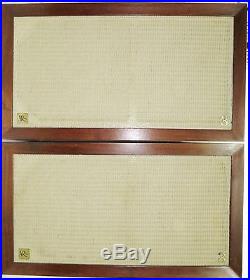
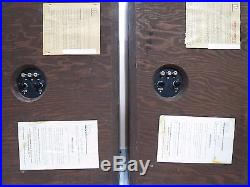
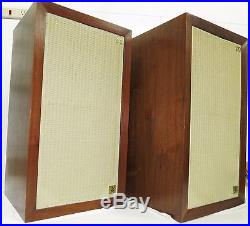
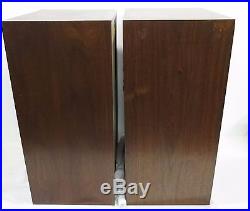

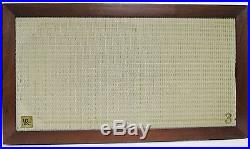
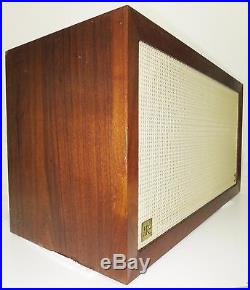
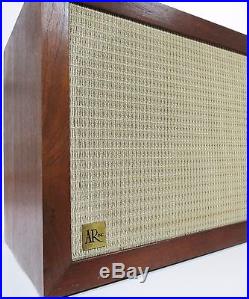

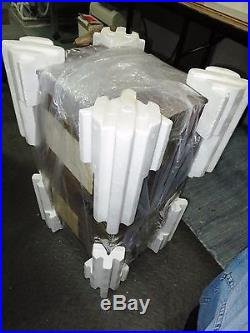
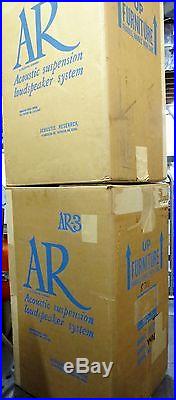


Each speaker carton weighs 60 lbs. Specific AR-3 Item Description. This pair of AR-3s, oiled-walnut finish, serial numbers C 33230 and C 46091, were manufactured in approximately September 1964 and December 1965. There are no significant differences in the run between these two models, and AR was producing 500-700 AR-3s/month during this period, approximately. Considering the age of these speakers, the walnut cabinets are in excellent condition, and the front grill moldings are nearly perfect, without any sign of seam separation, a common problem with some older AR-1s, AR-3s and AR-3as. These seams are glued during fabrication, and some older ARs begin to separate at this seam; not the case for these AR-3s. The walnut cabinets have virtually no marks or scratches with only a few minor blemishes, and the corners and edges are virtually perfect, with no chips or dents. These boxes go with these speakers, thus enhancing the value of the speakers have original-style cartons. The grills have never been removed and are in fine condition and are straight and without holes or other blemishes, but they have faded and “yellowed” a bit over the years, unfortunately a characteristic of the saran (nylon-like) weave fabric used for the grills. The AR logo and the “3” pin are in fine condition, showing some slight oxidation over the years. The drivers work fine on these speakers, but the level controls are oxidized in the usual fashion, and the new owner will need to “exercise” (rotate back and forth) the controls to get contact. At some point, the new owner may want to remove and clean the Aetna-Pollock level controls and check the value of the crossover capacitors to be sure they are in spec and possibly update them. These speakers haven’t been opened. The oiled-walnut enclosures are therefore in excellent condition with only minor marks or scratches, and the seams and glue points are excellent, intact and have not pulled away, demonstrating the. Of long-term air-conditioned storage. This preserves AR speakersphysically and electro-mechanicallybetter than anything else. The grills have not been off of this pair. The walnut grain on these AR-3s is half-round flitch premium walnut veneer with solid-walnut grill edge molding, with a beautiful walnut grain and figure in lustrous and deep-color veneer. The solid-walnut moldings are perfect with no sign of separation whatsoever, and there are no chips or dents. The original AR, Inc. And 3 brass logo emblems are in very good condition, slightly tarnished, and are in the correct position on the grills, meaning that they have not been removed or replaced. The level controls have unavoidable drop-outs due to oxidation, but with enough movement of the controls, the levels can be set at the dots, as originally indicated. Copies of the original-type paper work supplied with the AR-3 are provided with the speakers. Both AR-3 speakers produce clean sound from all drivers, and the woofers produce powerful, undistorted deep bass effortlessly. There is no evidence of any surround issue with these #3700-series Alnico woofers with treated-cloth surrounds. In my experience, few of these woofers have a surround problem, but some do dry out over time, and the bass response can suffer. The midrange and super-tweeter drivers on both work well with the expected “reticent” output, but this is pretty much the way is has always been for the AR-3. It doesn’t jump out at you, but the sound is remarkably smooth and effortless. Acoustic Research AR-3 History. To knowledgeable audiophiles and historians, the Acoustic Research AR-3 needs no detailed introduction. From its commercial introduction in early 1959 throughout the next decade, it was considered to be one the finest and most accurate loudspeakers commercially available at any price. At this point in history, the AR-3 has become a high-fidelity icon, arguably the most famous loudspeaker in history. The AR-3 was developed at Acoustic Research by founder and researcher Edgar Villchur. Its design was based. On scientific research and industry-standard objective-measurement techniques with published performance, pioneered by Acoustic Research. ARs standardized-measurement techniques, using their anechoic chambers and reverberant-test chambers, were. Repeatable by other testing labs, and AR led the entire high-fidelity industry in publishing the results of this testing. This was somewhat controversial at a time when most loudspeaker companies more or less exclusively used listening tests to develop loudspeakers, and generally kept their internal testing results proprietary. The result of ARs objective design philosophy was a no-nonsense product capable of high acoustic accuracy. In fact, the only subjective validations of the AR-3s accuracy were the many public live. Recorded concerts and comparisons conducted by AR in the early 1960s, and these, too, set industry standards that have not been surpassed to this very day. The AR-3 was the first commercial loudspeaker to use direct-radiator, hemispherical dome midrange and tweeter drivers. These dome drivers, as well as the acoustic-suspension woofer system (first used on the 1954 AR-1), were covered under AR patents. The acoustic-suspension woofer and dome tweeter are commonplace and virtually universal in the speaker industry today. As a lasting tribute to this remarkable piece of history, an AR-3 is on permanent display in The Natural Museum of American History of the Smithsonian Institution. When the AR-3 was introduced, it had no peer in terms of low-frequency extension, low distortion and extended, high-frequency acoustic-power response. It is still considered to be one of the finest loudspeakers ever designed. Its place in history was made secure during the early 1960s when Acoustic Research conducted dozens of public, live. These bold, live concerts compared pre-recorded music on AR-3s to the Fine Arts Quartet, classical-guitarist Gustavo Lopez and a restored 1910 Seeburg Nickelodeon. In virtually every demonstration, listeners were. To detect the switchovers between the live musicians and the reproducing AR-3 loudspeakers. The accuracy with which the AR-3 reproduced the live musical instruments is almost uncanny, and most experts in the field consider this the. Test of loudspeaker accuracy, where the reproducing instrument is asked to reproduce the live sound rather than being “A-B’d” with another speaker; and to put this accomplishment into better perspective. It is a remarkable testament to both the AR-3 accuracy and Edgar Villchur’s understanding of the proper way to record and reproduce live musicians and instruments. Because of the AR-3s remarkable critical acclaim and ground-breaking innovation during this period, it quickly became a classic loudspeaker design, and has become a. Audio legend Julian Hirsch said of the AR-3 in his 1960. The sounds produced by this speaker are probably more true to the original program than those of any other commercially manufactured speaker system we have heard. The leading consumer-testing organization stated that the AR-3 had the deepest bass ever measured in their laboratories. AR-3 Performance and Physical Description. The AR-3 is a 3-way, full-range, 4-ohm acoustic-suspension loudspeakertechnically a bookshelf speaker for very sturdy bookshelveswhich. Includes the now-famous AR 12-inch acoustic-suspension woofer and a dome midrange and tweeter. The enclosure size is exactly optimal for the 43 Hz resonance frequency, and the restoring force ratio is approximately 80% acoustic and 20% mechanical, far greater than the bulk of current consumer loudspeakers using the a/s design. This is one reason why the AR-3 has much lower harmonic distortion than nearly any current-design loudspeaker in a comparable size. This woofer has a large 9.6 lb Alnico-5 magnet assembly, cast-aluminum frame and a long-throw, 2-inch heavy copper voice coil with a linear excursion of 5/8-inch and a maximum excursion of nearly 1 inch. The midrange driver has a 2-inch phenolic-dome (hemispherical) diap. Gm with a self-supporting, 2-inch aluminum voice coil and a 9.2 lb. The super tweeter uses a 1-3/8-inch phenolic-dome diap. Gm of the same design with a 3.3 lb. Alnico-5 magnet assembly, and the drivers have LC crossover frequencies of 1000 Hz and 7,500 Hz. High-frequency dispersion, measured 45° off-axis in any direction is -3 dB at 10 kHz and -7 dB at 15 kHz. The dome midrange and super tweeter have very wide dispersion in any direction when measured off-axis, and the system has exceptionally wide and uniform acoustic-power response. Uniform polar response measurement of this system was greater than 90° at 8 kHz in any direction, even with the grill molding in place. Harmonic distortion is less than 1.5% above 35 Hz and 3.2% at 30 Hz, with >10 watts input. At 20 Hz with over 20 watts input, distortion is less than 8%. Few, if any conventional speakers made today can surpass, let alone equal, this level of quality in low-frequency performance. Low harmonic distortion, the AR-3 is capable of strong, fundamental bass energy down to 30 Hz, with usable but diminished response to below 20 Hz. The speaker is approximately 0.5% efficient, meaning that an amplifier capable of at least 25-50 watts-per-channel is the. The AR-3 dimensions are 14 x 25 x 11-3/8. The AR-3s net weight, each, unboxed, is 52-54 lbs. Overall Description covered by. Reproduction or copying of any of this material without the express permission of the writer is unlawful and prohibited. Additional Comments on the AR-3 Performance taken from Edgar M. Villchur: A Tribute, by Tom Tyson, December 3, 2011. By 1958 Villchur completed development work on a new loudspeaker using a “revolutionary” new tweeter design. His research led to one of the simplest of devices to reproduce high frequenciesthe dome tweeterthe first of its type to be used in a commercial loudspeaker. Basic dome-shaped diaphragms had been used in horn-type tweeters dating back into the 1920s, but never as a direct-radiating tweeter. Villchur’s final dome design, looking as much like a small reddish-orange “fried egg, ” had very low distortion, smooth response and wide dispersion, but it did not come easy, as Villchur went through nearly 250 prototypes of soft and hard materials before a workable model made from phenolic-plastic material was completed. The soft-dome prototype, using a cloth dome coated with butyl-rubber, provided some efficiency gains but poorer off-axis dispersion and was rejected in favor of the plastic dome. The dome shape provided a rigid, piston-like diaphragm, and the position of the voice coil at the. Villchur’s dome used an aluminum voice coil suspended in the gap with urethane foam, without the typical bobbin or “former, ” thus assuring low mass and simplicity for the total moving parts. 3,033,945, was issued on May 8, 1962. The finished product was to become the AR-3 loudspeaker, using the AR-1 low-frequency section and a new 2-inch dome midrange tweeter and 1-inch dome “super” tweeter. A prototype of this remarkable new loudspeaker was shown in the 1958 summer hifi show in Chicago to gauge public reaction, and in October, the final version of the AR-3 was exhibited at the New York High Fidelity Music Show. In the words of Abe Hoffman, it was the hit of the 1958 New York hi-fi showthe only really new development this year in speakers. It was reported that AR sales had grown over 200% in 1959 alone due to the AR-3 and AR-2a model introductions. An early test that summarized the outstanding quality of the AR-3 was reported by Hirsch-Houck Laboratories in the October, 1960, issue of High Fidelity magazine. Julian Hirsch stated that The sounds produced by this speaker are probably more true to the original program than those of any other commercially manufactured speaker system we have heard. ” Hirsch continued, ” Prior to performing any tests on the AR-3, we listened to it for some time. It was compared against other fine speaker systems, including those with high-quality electrostatic tweeters. The listening test showed beyond doubt that this was a superior speaker systema match for any composite system we could compare it to. Live- Versus -Recorded Concerts. In the summer of 1959, Villchur and the Fine Arts Quartet, in conjunction with Concertapes-Concertdisc and Dynaco, began a series of 75 public live- versus -recorded music concerts that were performed in several major cities across the country. Members of the press and the general public were invited to these concerts, featuring Villchur’s new AR-3 speakers alternating with live music of the Fine Arts Quartet (and subsequently guitarist Gustavo Lopez and a restored 1910 Nickelodeon). These concerts were very successful and received positive comments from the high-fidelity press, newspapers and the public. Those in attendance at these concerts generally could not detect the switchovers from live music to the AR-3s reproducing the same music. It is noteworthy that in addition to the AR-3’s high level of sonic performance, Villchur’s analytical and careful preparation for these performances made these AR live- versus -recorded concerts remarkably successful, and AR’s reputation in the industry for making accurate loudspeakers continued to climb. Towards the end of these concerts, Villchur published an article describing the method of conducting these concerts, “Techniques of Making Live-Versus-Recorded Comparisons, ” Audio , October 1964, yet despite this, there are no reports that any company or individual has succeeded to this degree with similar public live- versus -recorded demonstrations. In many respects the AR-3 loudspeakerone of the most important high-fidelity loudspeakers of all timemight be considered Edgar Villchur’s greatest achievement, an embodiment of two of his principal inventions, the acoustic-suspension woofer and the dome tweeter. In 1993, an AR-3 was placed on permanent display in The National Museum of American History of the Smithsonian Institution , Washington, DC. The item “Acoustic Research (AR) AR-3 Speaker Pairr, OW Cabinets, SN C33230/C46091, VGC” is in sale since Saturday, May 21, 2016. This item is in the category “Consumer Electronics\Vintage Electronics\Vintage Audio & Video\Vintage Speakers”. The seller is “acoustic-research-inc” and is located in High Point, North Carolina. This item can be shipped worldwide.
- Brand: Acoustic Research “AR”
- Model: AR-3
- Country//Region of Manufacture: United States
